(www.stopdown.net)
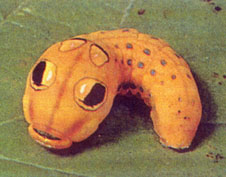
|
Science (www.stopdown.net) |
|
Left: a snowflake. Right, a cargo protein walks (like a person walks, one foot in front of the other) along a microtubule in a cell, carrying a bundle of molecules for delivery. | ||||
| Far left: a supernova, or exploding star, in which higher elements (larger atoms) are born. Near left: probably a fish hatchling, not sure. Right: swallowtail butterfly larva, with false eyes to ward off predators. |
 |
|||||
| For some images of aquatic life from "The Deep" (www.thedeepbook.org) click here |
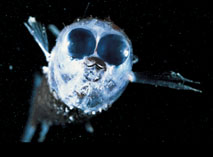 |
For some pictures of squids and octopuses click here |
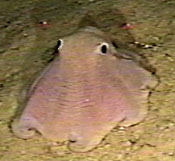 |
| Click here for
discussion page on science.
.........Reader comments can be posted on this science discussion page, or
e-mailed, or mailed in a letter. See contact us
to search definitions of science vocabulary we recommend www.wikipedia.org Stopdown pages: Basic components of life: atoms, molecules, cells and organisms, click here. This page is a quick look at atoms combining to make molecules, molecules combining to make cells, and cells combining to make organisms. Math,....click here ( includes editor's favorite problem: What are the odds that three points on a circle fall in a semicircle? Any semi-circle) Stopdown page on basic concepts of Special Relativity. click here. Einstein's theory of Special Relativity, is based on the seemingly impossible claim that the speed of light from a single source is the same for all moving observers. Stopdown comments on electron orbitals, the basis of chemistry, the "wave-particle duality", and quantum tunneling: Click here. It is the wave nature of particles that confines electrons to their orbitals, something that is not looked at in basic chemistry classes, leaving orbitals as a mystery. The leap of mind whereby Louis de Broglie conceived that seeing electrons as waves would explain why they are confined to orbitals, is about as simple and beautiful as scientific revelations get.
Articles and links Link: Science Daily: for a great free site with science and medicine articles on all topics click www.sciencedaily.com Link: The website for Science News, lots of free articles click here www.sciencenew Birds use tools, smart birds. (Links to youtube) For an article and link to videos of some very smart birds, click here. Click the first link that is offered, or click here: one famous example from Oxford University, for a video of a New Caledonia crow bending a wire to make a hook to retrieve food. The New Caledonia Crows spend a comparatively long time raising their young, have especially developed brains, and are exceptional among birds in their ability to use tools. Crows and ravens in general are very smart. In a video from Japan, crows drop nuts on roads so they can retrieve the opened nut after cars have cracked the shell: click here. To avoid traffic they drop the nuts in a crosswalk and retrieve them after traffic has passed and the light is green for pedestrians! The lyre bird, whose males attract females by delivering the mostcomplex song they can, copying other bird calls and ambient sounds perfectly. At the end of this segment he makes a sound like a chain saw he has heard cutting down the forest. It is incredible.For lyrebird click here. For another lyrebird video, click here. For a video of a bird using bait to catch fish, click here. For a video of a crow retrieving a series of tools to get the one that will access the offered food, click here. For a parrot dancing to music, click here. This is all youtube links. There are more of these bird videos worth looking at. Details of Malaria/sickle cell anemia connection are revealed . People with sickle cell anemia have a degree of protection against malaria. The basics of the biochemistry involved has been clarified. The red blood cells of people with sickle cell anemia stop the malaria parasite from making the cells stick to capillary walls. So they are processed to the spleen like normal, and the spleen spots and kills the infected cells. click here Solar Fuels: using concentrated sunlight to deliver energy rich molecules that can be used as fuel. Focusing sunlight with mirrors is a simple way to intensify solar energy, and one might think this approach could be used to: boil water to make steam to drive a turbine. Apparently this is not efficient or cost effective or it would be happening. For a Science Magazine article about using focused sunlight to drive (cook, heat) chemical reactions which will yield fuels that will burn cleaner than coal and gasoline, click here. For example, hydrogen and oxygen could be produced from water by splitting water. Then the hydrogen and oxygen could be recombined, an explosive reaction which is the fuel burning, giving back water as exhaust. Can't get much cleaner than that. More complex molecular products are among the various fuels being researched. Using sunlight to drive "uphill" (that is fuel-producing) reactions may be the wave of the future. Lots of scientists are working on these ideas, but the money is not there to carry the ideas forward to commercial energy production. Photosynthesis, whereby plants use sunlight to generate fuels including sugar, does what solar fuel scientists are trying to do with solar-driven chemical reactors. A low calorie diet confers longer, healthier life on mice: some details. A low calorie diet causes cells to recycle tissue and protein to generate more essential protein at the expense of less essential protein. The structures inside cells that do the recycling, proteosomes and lysosomes, also function to digest defective protein and defective mitochondria, both of which cause disease and aging. Thus enhanced recycling in response to fewer nutrients (low calorie diet) seems to enhance recycling of disease-causing molecules. Click here for article Biology Naked role rats have few predators, which lets the species have offspring later in life so that they live ten times longer than mice, which have many predators. Naked mole rats have a very restricted diet, another promoter of long life. There is yet another longevity issue involving cancer resistance and DNA sequences called telomeres. Mice usually die of cancer, whereas naked mole rats don't get cancer partly due to a highly sensitive system for "contact inhibition," which stops cells from growing when they make contact with another cell, and thus impedes cancer's runaway growth of cells. Which leads to another longevity enhancer: lacking a cancer risk, naked mole rats can afford to keep an enzyme, telomerase, turned on. Telomerase replenishes telomeres, repeat sequences at the end of chromosomes which shorten with every cell division, leading to degradation of cells and aging. In humans and most animals telomerase switches off, so that runaway cell growth (cancer) will lead to cell death, due to depleted telomeres, and many starting tumors thus self-destruct. The downside of switched-off telomerase is the deterioration of cells and aging. So naked mole rats, with their special defenses against cancer, are exempt from this driver of the aging process. Life for naked mole rats, however, is no Shangri-La, as the article details. For article click here...For Wikipedia page on these creatures, strange in many ways, click here. The long-nosed echidna was so reclusive that a field study was not done until the one described in this article. These animals are kin to the duck-billed platypus. They are mammals that lay eggs and have variable body temperature. (You'll have to ask a biologist why they are called mammals.) For article click here. Scientists claim that sea sponges contain chemicals that thwart bacterial immunity to antibiotics, as demonstrated in the lab. These chemicals may protect sponges in bacterial attacks that kill other plants and animals but not sponges. Click here for article. (Report from the Hollings Marine Lab in Charleston, presented at the AAAS meeting Feb. 14, review by Science News) Article: The Sahara was green not that long ago. From about 10,000 years ago until about 5000 years ago the Sahara desert area of Africa was green, as a recent excavation of human remains illustrates. Click here (Although this site supports controls on greenhouse gases (like auto emissions) because it appears they are changing the climate, it remains a fact that natural climate is not a stable affair, viewed over thousands of years. Thus it is not inconceivable that the current climate changes are not basically natural but pushed along by human industry. ) Article: Cuttlefish are masters of camouflage even though they are colorblind. Click here For a website that that uses animated sequences to describe biochemical events in a living cell click here. This is a wonderful site by people at North Dakota State U. in Fargo. If you don't understand the terms you can search them on wikipedia.org Article: The standard kilogram, a cylinder cast in 1889 in England and kept under guard in a chateau outside Paris, is getting lighter and no one knows why. Click here. Article: A Baboon troop remains peaceful 20 years after dominant males died out from disease contracted foraging at a trash dump. Only aggressive, stronger males foraged there. New males joining the troop have adopted the peaceful ways rather than reassert belligerent behavior patterns. Click here. For a web page on animal mentality click here. Article: Hornbill birds are able to distinguish between different monkey warning calls, reacting according to whether the predator that the monkeys are warning each other about threatens them, the hornbills, or not. Click here. Article: Donald R. Griffin died recently. Dr. Griffin, with Robert Galambos, proposed that bats navigate by sonar (by hearing echoes of sounds they emit) and because the renown this brought him, he was listened to by skeptical scientists when he argued in 1978 that animals have minds. (In the past many, perhaps most scientists took a dim view of the idea animals had minds. Biology was much more of a "descriptive science" than it is now. The two articles listed above this are good examples of the new knowledge that has dispelled the old thinkng. click here Article: Adults of the Brazilian Pirahã tribe don't use numbers over two and are frustrated by simple number exercises that their children, exposed to outside culture, are able to perform. Click here. Article: Scientists are connecting electrodes to the tongue to transmit visual information to the brain. Click here Article: Scientists are studying how large biomolecules function so articulately. Click here. Article: Fast-reproducing bacteria provide a window on natural selection. Click here Article: Subatomic particles merging. Click here. Article: A species of squid mothers carry eggs for months, contrary to accepted view that, unlike octopuses, all squids merely deposit new eggs on the sea floor. Click here for article. Article: After daily exposure for ten days to a larger belligerent mouse, subject mice retain withdrawn behavior in the company of ordinary mice, and they retain altered brain chemistry, for weeks. The chemical agent held accountable is active in addiction chemistry and in an aspect nerve growth linked to anti-depressive medicines. The mice with the induced syndrome responded to Prozac. Click here Stopdown pages: Basic components of life: atoms, molecules, cells and organisms, click here. This page is a quick look at atoms combining to make molecules, molecules combining to make cells, and cells combining to make organisms. Math,....click here editor's favorite problem: What are the odds that three points on a circle fall in a semicircle? (Any semi-circle) Stopdown page on basic concepts of Special Relativity. click here. Einstein's theory of Special Relativity, is based on the seemingly impossible claim that the speed of light from a single source is the same for all moving observers. Stopdown comments on electron orbitals, the basis of chemistry, the "wave-particle duality", and quantum tunneling: Click here. It is the wave nature of particles that confines electrons to their orbitals, something that is not looked at in basic chemistry classes, leaving orbitals as a mystery. The leap of mind whereby Louis de Broglie conceived that seeing electrons as waves would explain why they are confined to orbitals, is about as simple and beautiful as scientific revelations get.
|
| Some questions of
the sort we would like to receive comments on. e-mail: ericqb@msn.com |
||
| Carbon, the atom which is the basis of life chemistry,
makes four bonds. As shown on the right the bonds -- to hydrogen atoms --
are arranged so that the hydrogens will be spaced as far from each other
as possible. If you use a ball of clay and sticks to simulate bonds
you can see that four is a good choice for making the wiggly chains of
life. It covers all angles, unlike three bonds, and yet it is
simple. Five is messy, whereas six is orderly but crowded. Question:
Would there be life on earth if there were very little or no carbon? I
have been told that silicon, though it makes the right bonds to be like
carbon, is not
electronegative enough to substitute for carbon. [A good way to present this geometry to students is put four sticks in the clay ball so that they are equidistant in a plane, (making a cross with the ball of clay at the center), and ask the student to arrange the sticks so the outer ends will be as far apart from each other as possible ( as shown to the right).] |
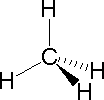 |
When light waves interfere and either cancel or reinforce, dark and bright bands appear where the light hits a screen. In the dark bands the light has disappeared, in what would seem to be a violation of the principle that energy cannot disappear -- "conservation of energy." The vanished light is supposed to show up in the bright bands, physicists say, but explanations I have seen are over my head. I would like to know how the energy content of the bright bands is quantified in terms of the component that derives from the dark bands.
What does it mean that red, green and blue light combine to give clear light? Is this a physics question or a biology question or both?
Above, (under the section title "science") is a picture of a supernova, an exploding star which is the event that creates most of the types of atoms. Supernovas are therefore the birth of chemistry and, thus, life. Question: Does the earth have more elements (types of atoms) than the other planets, as appears to be the case? If so, why?
The placebo's placebo: It was recently observed in a clinical trial that a group which was not given a placebo, and not given the drug under study, but rather was simply given nothing, had an outcome about like the placebo group. This would mean that much of the "placebo effect" data is not attributable to the psychology of getting a pill, a position widely held by scientists. I have lost the citation for this study, which seems to have been swept under the rug and forgotten. I would like to get a citation for the original and follow-ups.
| Commentary.......Two German scientists wrote in Science, April 8, 1994, that molecules in a cell behave with a quality of cooperation that is like that of insects in a colony, and that this level of cooperation cannot be explained by existing models. Indeed, life looks more like a conspiracy of molecules than an accident of molecules. Evolution, while it obviously a fact of organisms in nature, does not explain how organisms formed up out of chemicals, an event that would seem to violate the physics principle that complex chemical systems, after they form by accident, will be quickly broken down to smaller, simpler forms. (Ordered states contain energy which is released by a change to a more random state, randomness is called entropy. This trend is the way of nature, according to physics (the second law of thermodynamics) which is also a law of chemistry. Life runs against this trend, like a house of cards surviving and growing in a room full of puppies. (The puppies are the smaller molecules bumping into and breaking down the more complex structures) Once organisms have formed, complexity confers advantages in the game of eat and try not to be eaten, and reproduce -- so complexity is fostered by evolution. But this still does not explain the intelligence of molecular systems in life in the first place: what drives these systems ever upward in complexity -- to say survival does not explain the will to survive and reproduce. Just because biomolecules form in the lab under various conditions does not explain the irrepressible chemical mania of self-organization that is life. We would like to argue that there is mystery in all this that scientists don't talk about, with rare exceptions like the German chemists cited above, perhaps for fear of endorsing far out notions like a "life force" in nature, or worse yet, "intelligent design." The future of chemistry may be a realm in which lots of new abilities of biomolecular systems, such as self-organizational fields (life force), newly recognized abilities of biomolecules to communicate (like quantum tunneling) and other properties now considered daffy daydreaming will become serious science. ..... There is evidence that organisms may evolve with deliberate rather than accidental mutations, and there is even some credence for the possibility that learned abilities can be passed on to offspring. These notions are contrary to what post-Darwinian evolution theorists have held -- that mutations which give an organism an advantage occur by pure accident, and are then "selected for" because those with the new mutation have a survival advantage in a changing ecosystem. The explanation for learned abilities being transmitted to offspring is that the genes don't change, but a regulatory switch that controls a given gene is activated in the offspring by signals from the mother......If biochemistry is getting more curious, physics has long been a crazy place, from relativity to quantum mechanics. It is a world of ghost particles and time going backwards(QED), the mass of a star squashing into a space the size of a suitcase -- (or is it the head of a pin? "black holes"), light from a single source having the same velocity for all moving observers (Special Relativity), etc. The old scientific view of nature as something that can be taken apart and put back together like a watch -- thus showing that nature is a predictable machine of lifeless parts -- is being eroded by the advances of science. | A larva forms its stomach. |
................................................................................................................................................................................................................
Click here for discussion page on science. .........Reader comments can be posted on this science discussion page, or e-mailed, or mailed in a letter. See contact us
| Science: life chemistry, physics, etc. {There is repetition of ideas found above in the following comments, which attempt to give a broader picture of the intentions of this page.} We would like to discuss scientific ideas of all sorts, including basic questions like why the electron does not dive into the proton, or what it means that red green and blue light combine to make clear light. We would like to ask readers to post here or send us thoughts about new scientific mysteries, as well as thoughts on any scientific issue. We would like to look at hard-to-explain intelligence and communication in life forms from larger animals down to insects and bacteria, right down to molecules as they go about their business in the chemistry of life. Some examples: Birds and bats in a flock, and fish in a school, are able to move in unison in a manner that scientists can't explain. Ants and bees present a similar mystery in their ability to all do their different jobs, like foraging for food or caring for young, in a coordinated way without any management. (This surprising fact is observed in the Bible, Proverbs.) All sorts of insects and small creatures show amazing abilities, such as the parasite that makes a rat fail to smell a cat, so that it is more likely to get eaten by a cat, into whose stomach the parasite must get if it going to complete its life cycle and reproduce. At the level of cells, deemed the smallest living things, disease-causing bacteria swap genes that give resistance to antibiotics, sometimes between different species of bacteria. Stem cells, which are immature cells that haven't turned into a functional cell (such as a muscle, skin or or blood cell) can migrate to damaged tissue, as in the retina of the eye, and turn into the type of cell needed (perhaps by fusion) and replace the damaged or dead cells. (Therapy to restore damaged heart tissue with stem cell seeding has worked in animal experiments.) Smaller and less complex than cells are large molecules, including viruses and regular DNA, which are very smart chemical machines, such that it may not be right that we don't call them living. Smaller molecules also seem smart, cooperating and communicating in ways that would seem to be beyond the means of chemical bonding via accidental collisions of molecules, the presumed basis of life chemistry. One example is DNA repair, in which proteins converge on a damaged gene and work like a surgical team to repair it, improvising if a team member is absent. .....In recent years astronomers have claimed to see, in the motion of our galaxy (the Milky Way), a huge gravity force exerted by an unseen presence they call dark matter. Also in recent years astronomers have discovered in the the motion of very far away exploded stars, called supernovas, an unexplained super antigravity which is causing the universe to speed up in its expansion. (The accepted view had been that the universe was expanding, but slowing down in its expansion.) Scientists were repeatedly telling us just a few years ago that they were on the brink of being able to tell us the fate of universe, because they would know if it had the "critical mass" to keep it from expanding forever. Whether neutrinos have mass was one issue that, if resolved, would decide the fate of the universe, we were told. Scientists have declined to reminisce publicly about the prematurity of their declarations in the 80's, but they do say the universe is a whole new ballgame and they have only speculations about what these new forces are. The concepts of inertia, space and gravity appear to be slipping from our grasp as we once knew them, which was already plenty strange since relativity and other 20th century theories.... Physics (including astronomy) is full of quite crazy ideas, illogical ideas that are fun to ponder and we wish to discuss, like the "wave-particle duality" and relativity, which says space and time are variables. Einstein, the godfather of crazy physics, had a hard time himself accepting some of the wild stuff that appeared in his lifetime, even doubting his own theoretical prediction that there should be what we call "black holes." Einstein also derived from precepts of quantum physics the argument that particles, like protons, which are synchronized and then sent in different directions, can maintain their connection over large distances, such that forces acting on one particle will be responded to by both particles. Einstein put this argument on the table to show that certain premises of quantum physics must be wrong, or they would not lead to such a crazy outcome. But scientists came to accept as fact this phenomenon of "action at a distance." |
These (below) are some of the smallest things that are like a higher animal in form: eyes, head, body, internal organs including digestive system, arms and/or legs. They have brains, and though we tend to presume not much goes on in their brains, we don't know. These are our little cousins, and, if you believe humans evolved from monkeys, and monkeys evolved from earlier life forms, then these little creatures are our ancestors. If you don't believe in human evolution, that is no reason to deny that we are cut from the same cloth as these creatures and share many attributes with them, including mortality -- we are born and we die. I would like to build a file with links to other sites pertaining to plankton and other small creatures, looking at their abilities and aspects of their biology....I would like to post videos of these creatures and how they live.
| plankton | plankton | plankton |
....................................................................................................................................................................................................................
Supernova explosions, below, can follow the contraction of a dying star into a small spinning mass. The higher chemical elements (larger atoms, with more protons and neutrons and electrons) are formed in these events. In other words these beautiful light shows are the birth of chemistry, and hence the birth of life. Question: The earth, compared with other planets in the solar system, seems to have an especially large and diverse set of elements, like oxygen. gold, phosphorous, neon etc. ? Is this true? If so what are the proposed explanations?
Goals of this page
We want to post commentary about sophisticated ideas in science, trying to steer the language toward letting those less well-versed in science follow the ideas and contribute ideas. .....We want to provide pages and links that can offer a quick study of terms and concepts that the "science-literate" know, but most people don't.............It is important to understand science to be a responsible citizen, to make good business decisions, and to take care of one's health and one's family's health. Besides that, science is exploding in knowledge and new mysteries that lie behind each newly opened door, and it is fun, in a profound way, to witness the wonders and surprises nature serves up. ......By learning the basics in science one can look at research frontiers and the strange, even sort of crazy ideas in science that have become accepted as true. For instance the wave-particle duality, in which waves behave like particles and particles like waves, can be understood by learning what interference patterns are with light. Once one sees what interference is about in a wave form, and this is not difficult, then one can look at how particles make patterns that only waves ought to be able to make, and thus ponder the wave-particle duality....Likewise, by learning terms like synapse, enzyme, antibody, vesicle, whose meanings are easy to understand, one can look at research in life science, including medicine. ( A synapse is an interface between two cells where the cells talk to each other chemically, specifically nerve cells and immune cells. For our page which takes a look at synapses, vesicles and other elements of life chemistry click here. An enzyme is a catalyst in a cell: a molecule which speeds up a specific reaction between two other molecules. An antibody is a molecule that attaches to foreign microbes, which carry identifying molecules called antigens. One role of antibodies is to attach to a foreign microbe and mark it for destruction by killer t-cells. A vesicle is like a taxi for carrying chemicals to destinations inside a cell.) The things scientists are learning about life chemistry are fun to learn -- it's kind of like a video game -- and it's much more interesting than is was 20 years ago. We would like to put together materials that will help students learn this game......It is, above all, the lack of knowledge of the meaning of scientific words that separates most people from an understanding of science. The ideas are not beyond most people, if people knew what the words meant.... We would like to have a page of good ideas for hands-on demonstrations...We would like to look at of the beauty of structure in nature. Like the fact that plants breath in carbon dioxide and breath out oxygen, while animals breath in oxygen and breath out carbon dioxide, and that a plant collects energy from sunlight that is released when wood is burned or when an animal eats and metabolizes the plant. As Isaac Newton put it, speaking of the energy of sunlight reducing the mass of the sun while causing plants on earth to grow, an increase of biomass, "Nature has many such transformations, and she seems to delight in them."
...................................................................................................................................................................................................................................
Help with terms and concepts. For any scientific term or phrase, like DNA, acceleration, quark, search it on Wikipedia. For an online dictionary of biology click here ....For basic, online survey text on molecular biology with search option and ideas click here ......... .For a biology site with dictionary and texts, search on Google EverythingBio or go to http://www.everythingbio.com/ (won't take hyperlink). Under the search box is a "select a category" box, you want to leave it on "glossary-word" for a definition.........To search a term or idea in life science textbooks on the EverthingBio site, enter the term or phrase in "search", then use the dropdown arrow in the "select a category box" and click on textbooks. Click submit. Pick a book, (we recommend one that looks like a survey course) and pertinent sections are offered. (Important: Click on illustrations -- e.g. "illustration 4.7" to view images, which are not presented alongside text.) {We have not found sites we like for physics or chemistry that will search a term or idea and use effective graphics. We are asking for e-mail suggestions.}
Life science: Some ideas we would like to discuss..
Life chose as its basis the carbon atom, which makes four bonds, as shown below, and it seems a good choice, compared with 2, 3, 5 and 6 bonds. A good exercise for students in school is to take a ball of clay and put different numbers of sticks in it, discussing the advantages of those bonding options. Four is has a lot to offer. It commands all directions, unlike three or two, but it is simple, unlike five, which is messy and confusing. Six is orderly but crowded. Four is sort of like the U-joint in a car, and it is easy to see how suitable four would be for making chains. Question: did life choose carbon or did carbon choose life? That is, if there were very little carbon on earth would there be no life? Below are pictures of carbon bonding.
 |
|
In the models to the left, four hydrogen atoms are bound to a central carbon atom. By making connections between carbon atoms, zigzagging carbon chains are formed. Much of life chemistry is based on these zig-zagging carbon bonds.
|
. To the right is a model of butane gas, an example of a zigzagging chain. Each carbon atom -- green -- makes four bonds. Although butane is not a chemical in life, it is a "fossil fuel" -- it comes from living things long decomposed. |
|
The human body harbors more bacterial cells than human cells. We would like to post a breakdown of the types of bacteria these are, and their roles in the human body, as well as discussion pertaining to the meaning, biologically, of our being host to so many parasites.
Disease microbes and other bacteria work together as a group to survive. Disease causing bacteria wait until their numbers are high, so they won't be easily mopped up by the immune system, before they emit toxins, counting their own kind through a system of chemical signaling called "quorum sensing." We would like to post comments, articles, links on the esprit de corps, the cooperative spirit, that exists among bacteria and even viruses, including the ability of bacteria to spin off genes to each other that provide resistance to antibiotics. (This can happen between different species of bacteria.)
When cells in plants and animals are no longer needed, as in a proliferation of immune cells that have eliminated a foreign microbe, or go awry such as a cell that may be turning cancerous, they commit suicide. This is called apoptosis, and it occurs for a variety of reasons. For a site addressing this phenomenon click here. We would like to do a page on apoptosis that is a little more colorful.
The AIDS virus (HIV) kills T-helper cells, even though very few of the cells that die are infected with the virus. This was recognized some years ago. Cell suicide, or apoptosis (see paragraph above), seems to trigger when it should not in the death of T-cells in AIDS. For a brief discussion click here.
Certain tissues of the body including the interior of the eye, do not mount an attack when exposed to foreign protein, or antigen. It seems that the same protein, "Fas" which is responsible for the destruction of T-cells under the influence of HIV (see last paragraph) is the protein that makes these unreactive tissues the way they are. For discussion click here.
Darwin's theory of natural selection says that a species changes because certain traits enable some members of the species to survive and reproduce, while other members which lack the trait die out. A species will thus change, or "evolve" because those best suited to a change in environment will redefine the overall species by surviving and reproducing where those ill-suited die off..........The mutations which confer survival traits are supposed to be accidental, not deliberate, according to post-Darwinian thinking. (Darwin was not aware of the early work describing genes that was going on in his lifetime. He did not himself declare that the biological changes permitting evolution were accidental, never deliberate.) Since the late 1980's some scientists have been studying bacterial behavior that suggests genetic mutations can be invoked by an organism in response to an environmental challenge, without going through generations of change. A bacterium can, if these studies are valid and the interpretation is correct, change its genes to its benefit with mutations that are "directed" and take effect in the bacterium before reproduction. (The random mutations of natural selection occur when a cell clones its DNA before dividing into two cells.) A 1991 study claimed that bacteria lacking a gene to digest lactose create that gene in response to being provided with nothing but lactose to eat. We are hoping to receive comments on this notion of "adaptive mutations", including citations for new evidence that supports its existence.
It is claimed that until the 1960's most scientists thought animals had no mind, that their brains were just switchboards for conditioned response and that nothing like a thought, emotion, or even consciousness could be attributed to animals. We would like to consider what animals are like in terms of cognitive events, like a bird making a nest. Does the bird know its making a home to live in and raise young, or does it just put the twigs in place without a clue? The recently deceased Donald Griffin, who, with Robert Galambos, discovered how bats navigate in the 1940's , was a major force in getting scientists to stop presuming animals are mindless. There is no scientific basis for such a presumption, Griffin pointed out. We do not know what a bird thinks. For article on Griffin click here.
Scroll down past the following physics questions for outlines of other chemistry/biology issues, on which we seek commentary from scientists and science junkies and anyone else: self-organizing biomolecules, the intelligence of molecules, life chemistry as a contradiction of the laws of thermodynamics.
Physics... Some ideas we would like to discuss.
The standard meter, a metal bar, is shrinking slightly. Why is it shrinking?. (Not the Lorentz contraction, we presume.) Likewise the standard kilogram is growing slightly lighter over time. We would like to post theories on these phenomena, including doubts that they are even happening.
Clear light passing through a prism separates into a rainbow of colors. (refraction) When red, green and blue light come together, clear light is the result. We would like to post comments from scientists and others about what this means, both as a physics event and a biology event.
Below: A beam goes through two slits as shown and the result when the light reaches a screen is an interference pattern: dark and bright bands. The bright bands are from waves that are "in phase" -- that is, their ups and downs coincide so that they add together, their light energy combines. This is called constructive interference, which is depicted in the wave forms shown below in "fig. 58". The dark bands occur where the waves are out of phase -- that is, the peak (up curve) of one wave coincides with a trough (down curve) of another. They are opposite and they cancel. As shown in fig.59, wave 1 and wave 2 combine and the result is no wave at all. This is called destructive interference. The light waves are still there, in a dark band -- take away one wave and the other appears -- but during destructive interference that energy somehow disappears. There are those who argue that "conservation of energy" is violated when the light disappears. According to the law of conservation of energy, energy cannot vanish, it can only change into another form...So, we would like to post comments on how the light energy that disappears in the dark bands migrates to the bright bands, as scientists claim is the case. One would expect that the bright bands would be brighter than the sum of their combined "reinforcing" peaks if they are receiving new energy from the areas of "destructive interference."
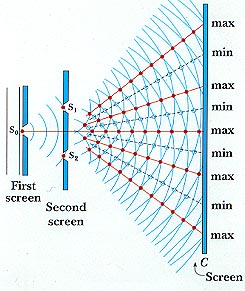 |
.Below is a picture of interference in water waves, as seen from above. We cannot see light interfering in this way. It is only when the light hits a screen that the interference becomes visible.
| Two objects are shown as dark rectangles at bottom of page are mallets, making two circular wave patterns by repeatedly tapping the water. The water waves are shown interfering.. The gray lines radiating out are where the waves are canceling, they are flat lines of "destructive interference." The dark bands in the picture above are the result of the same effect with light waves. The two mallets tapping the water give two wave sources just like the double slits above provide two wave sources. | 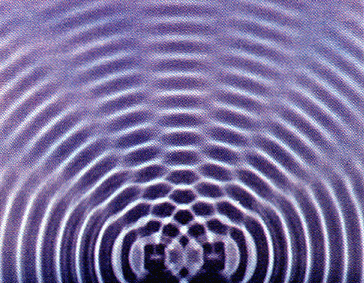 |
In the figure below, left: left is changed for right in the mirror. Why is up not changed for down?
 |
 |
In atoms (above, right) the electron and proton attract each other because they have opposite charge. ("negative" and "positive" -- arbitrary terms) The electron orbits the proton like a planet orbiting the sun. Question: Why don't the electrons dive into the protons in the nucleus? According to quantum physics the electron can only be at certain distances from the nucleus, and zero is not one of them. But survey textbooks in quantum physics do not give any discussion of what the thinking is as to why this should be. Neils Bohr's thinking on the angular momentum of the electron, must be accessible in terms that are not just formulas. We would be most grateful for references and commentary.
We would greatly appreciate a discussion of the reasoning that led to Plank's adoption of the quantum condition for energy in a "black body radiator," in 1900. Plank discovered, while studying the distribution of wavelengths inside a heated metal cavity (by studying the light coming from a hole in a metal container) that theory would fit the experimental facts if the energy rose in little jumps rather than in a smooth, continuous manner. But the college survey texts in quantum physics say no more about this issue, offering no explanation as to why little jumps work and a continuous curve does not. Isn't it kind of ridiculous that university students taking a course in quantum physics are told nothing about the most crucial, formative discovery in that area of physics?
{Trivia: Electricity was determined to be made of electrons, particles with a precise mass and charge, in 1897 by J. J. Thompson, who won the Nobel Prized in 1906 for that discovery. His son G. P. Thompson showed in 1927 that the electron was also a wave, for which he won the Nobel Prize in 1937.}
(Please excuse us for repeating this idea) In the 1980's scientists were constantly claiming that the next bit of data, such as data showing whether neutrinos have mass, was going to be the data that enabled scientists to determine the mass of the universe, and thus the fate of the universe. The expanding universe, we were told by scientists, would go on expanding forever unless the mass of the universe was enough to, by gravity, stop it's outward expansion and pull it all back together, perhaps in another "Big Bang." It turns out scientists were off on the mass of the universe by 90%, and were completely misreading the expansion dynamic. It was thought the universe was slowing down as it expanded. Now the universe is believed to be accelerating in its expansion. Has there been any discussion in the scientific journals about the false confidence scientists had in their assessment of the universe? If so we would most appreciate references.
It is said, with respect to particles at high speed turning into waves that when one tries to monitor the phenomenon the waves turn back into particles. Does the monitoring interfere with the particles, like radar or sonar bouncing waves off the thing they detect? Or is the monitoring "passive," as with our eyes seeing an object thanks to light that we had no connection with untio it reached us. Survey textbooks and articles fail to make this distinction, even though it is so important. One is obviously much weirder than the other, and it would seem this would have implications for the way one thinks about the uncertainty principle.
Two questions on textbook treatment of Special Relativity. (The following questions require an understanding of the Michelson-Morley experiment and Special Relativity. Click here for our discussion of Special Relativity. For Michelson Morley, search the net. Our discussion of M.M. will be posted soon) ....Question one: Is there anything wrong with the Michelson-Morley result, once we accept there is no ether? If so what? It would seem there is no reason to invoke the idea of the speed of light being constant in all moving frames, as textbooks do, to explain M.M. Without ether the M.M. result is intuitively correct. The apparatus is standing still, in physics terms -- it is an inertial frame, not an accelerated frame. There is nothing to cause a discrepancy in the split light paths, when the reconverge, is there? .........And, question two: the M.M. apparatus is contained in one inertial frame. So why invoke relativity, an issue of different moving frames, as showing the meaning of an experiment that does not have separate moving frames? There is a version of M.M. using starlight, but that is not the one they use in textbooks. With starlight there are different moving frames. But with the standard M.M. apparatus there is only one inertial frame, and no light source or receiver outside that inertial frame. Relativity is irrelevant.
Discussion: self-organizing molecules, self-organizing biomolecules, biochemistry. Below are some thoughts on the topic of self- organization. We would like to post essays and commentary from readers on self-organization.
How do snowflakes form with perfect symmetry?
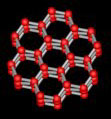 |
Snowflake formation raises the question of how such elaborate symmetry is maintained as the ice crystal grows, given the uniqueness of each snowflake. How does the six-sided lattice molecule (far left), from which snowflakes all begin, branch out in an infinite variety of ways while maintaining the six sided symmetry? How is it that water molecules attaching on one side mirror what is happening on the other end of the crystal, to give a unique, symmetrical snowflake? | 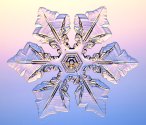 |
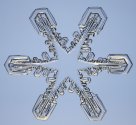 |
The accepted explanation for uniqueness is that as a given crystal grows it is moving in the air, and the conditions snowflakes encounter, humidity and temperature, are different for each snowflake. It is these conditions determine how each snowflake forms. The symmetry of snowflakes is attributed to the sameness of these conditions on the scale of the individual snowflake. The humidity and temperature on one end of the snowflake are the same as on the other side, because a snowflake is small enough for this to be the case, even as it moves through changing conditions. So what happens on one side is the same as what happens on the other.
But Wikipedia (online encyclopedia) cites an alternative view that is not out of the running on this issue.........."There are broadly, two possible explanations for the symmetry of snowflakes. Firstly, there could be communication (information transfer) between the arms, such that growth in each arm affects the growth in each other arm. Surface tension or phonons are among the ways that such communication could occur. The other explanation, which appears to be the prevalent view is that the arms of a snowflake grow independently in an environment that is believed to be rapidly varying in temperature, humidity and so on. This environment is believed to be relatively spatially homogenous on the scale of a single flake, leading to the arms growing to a high level of visual similarity by responding in identical ways to identical conditions..." We would be grateful to receive comments and references describing theory on how phonons and surface tension in the arms of a forming snowflake would govern symmetrical growth.
Something else worth thinking about is that whereas the conditions, temperature and humidity, may be the same across the snowflake, the trajectories of surrounding water molecules are all different. It must be, then, that the trajectories of soon-to-be attached molecules is not a factor in how these molecules are attached. We would be grateful for comments.
For excerpts describing how snowflakes form from a site on snowflakes click here Or go to the (Cal Tech) site SnowCrystals.com. Click on snowflake physics on the sidebar.
|
The following is an example of the kind of meaningless explanation that abounds in science-for-the-public articles. It is as if they would rather tell you a lie than confuse you with the truth, or they actually just haven't thought about the question. Why are snowflakes symmetrical (the same on all six sides)? "First, not all snowflakes are the same on all sides. Uneven temperatures, presence of dirt, and other factors may cause a snowflake to be lop-sided. Yet it is true that many snowflakes are symmetrical and intricate. This is because a snowflake's shape reflects the internal order of the water molecules. Water molecules in the solid state, such as in ice and snow, form weak bonds (called hydrogen bonds) with one another. These ordered arrangements result in the symmetrical, hexagonal shape of the snowflake. During crystallization, the water molecules align themselves to maximize attractive forces and minimize repulsive forces. Consequently, water molecules arrange themselves in predetermined spaces and in a specific arrangement. Water molecules simply arrange themselves to fit the spaces and maintain symmetry." By this explanation the arrangements are predetermined, starting from the initial hexagon, but that would mean all snowflakes would be the same. It is from about.com. |
|||||||
. Below is a diatom (and the skeletal debris of dead diatoms that form a mineral called "diatomite.") which is a living thing that displays the geometry reminiscent of the snowflakes above, which, of course, are not alive. We would like to discuss self-organization as a bridge between living and non-living forms, and look at self-organization in life chemistry.
Diatoms pictured below, are alive. They can be plankton or algae,
and have a silica skeleton.
|
|||
| Self organization runs wild: life chemistry is intelligent chemistry. It may not be intelligent design, but it is intelligent. The following are some thoughts about life chemistry. We would like to compose pages with graphics and animation that can get students interested in how life systems work. |
With respect to biomolecules, we would like to put together a gallery of molecular prowess, including photosynthesis and other biomolecular motors, DNA repair, protein folding, etc. Protein folding gives us one example of how a mechanistic view of an aspect of biochemistry has given way to something much more beguiling and complex, over recent years. A protein is a long string of amino acids that folds up into a shape it must take if it is to function in the cell. It was long assumed that the sequence of amino acids in a protein dictated the way the protein folded, but now it is known that a protein will take its shape even if many amino acids are out of order, and that helper molecules are required to shape the protein and degrade incorrectly formed ones. The old picture was one of something that was bound to happen given the sequence of amino acids. The new picture is one of molecular improvisation and collaboration.
In photosynthesis, a well known example of molecular prowess, light energy is captured to build a polymer sugar out of carbon dioxide, CO2, and water, H2O. The creation of the sugar is like six small tinker toys combining into a six-sided ring, and then these rings combining into a chain. The chain is the polymer sugar cellulose, which is plant fiber. When a piece of wood burns, the light that grew the plant is released as heat and light. Carbon dioxide is absorbed in photosynthesis, and oxygen is released. When the plant burns, oxygen is taken up and carbon dioxide is released....... This up an down: energy-absorbing with creation of structure, and energy-releasing with breakdown of structure, is of the essence in chemistry and biochemistry. (In biochemistry "anabolic" is up and "catabolic" is down, with the up reactions feeding on the energy released by the down reactions. In regular chemistry "up" is called "reduction" (contrarily) and "down" is called "oxidation.") We would like to post ideas on chemical energetics, including this one: how does the energy from one reaction get translated for use in driving another reaction?
.........................................................................................................................................................................................................................................
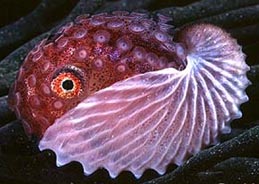 |
For a page of pictures of squids, octopuses, and nautiluses, click here. |
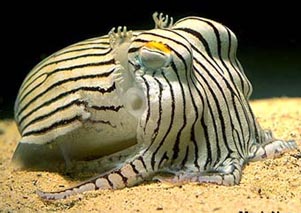 |
....................................................................................................................................................................................................................................................
Below: various aquatic larvae
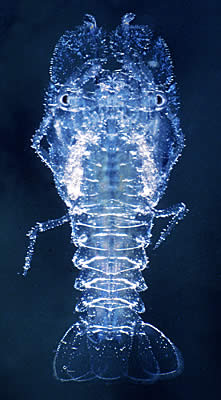
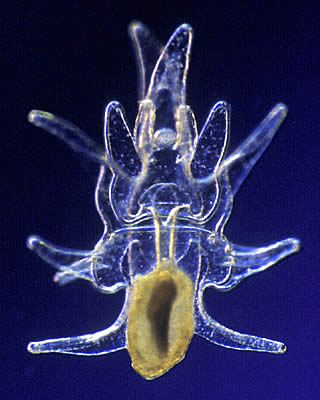
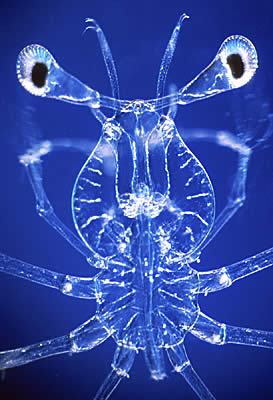
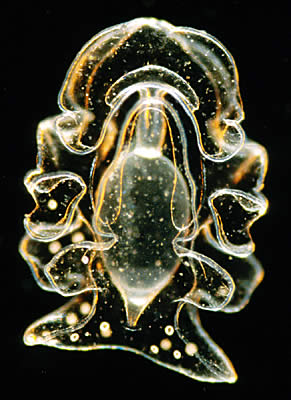

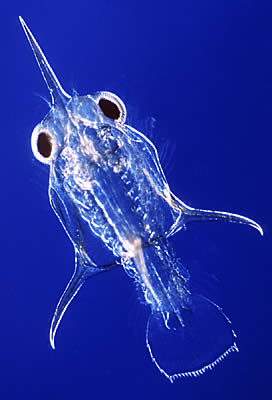
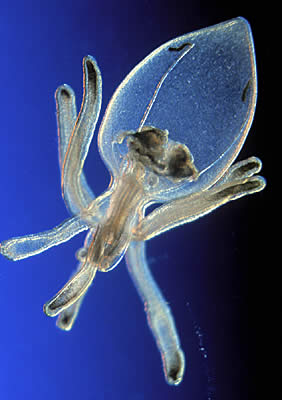
Commentary
(The following commentary is a found near the top of this page in different words.)
According to physics, (the second law of thermodynamics) molecules contained in a beaker can only take a downward energy path -- releasing energy, losing structure -- unless energy is put into the system, as by putting a flame under the beaker of chemicals. Some say that the upward path of life chemistry goes beyond a reasonable expectation of how much chemical order and complexity can arise from light energy hitting a collection of molecules...... The "second law of thermodynamics" says that everything in a closed system breaks down to random, less complex forms. The system's entropy, or randomness (the system's lack of structure) increases. The earth is not a closed system, but the mere input of sunlight or geothermal energy does not explain the fantastic complexity of life chemistry. This huge complexity of life chemistry where randomness is supposed to reign is justified in one argument by saying that in a universe so vast such an exception might occur, if rarely............. When a law of physics is disobeyed by life chemistry it is not very scientific to say it's a cosmic fluke. It is scientific to say something is going on here that we don't understand so let's discuss it. ....The idea that complexity arises from evolution, in that complexity often enables survival of an organism, does not explain what makes an organism form and want to survive and reproduce in the first place. Life appears to be a conspiracy of molecules, not an accident of molecules. It appears that there are forces of self-organization at work in life chemistry that are not understood. The two German scientists who wrote in Science Magazine in 1995 that molecules in a cell behave like ants in colony, were pointing to a mystery that is not usually discussed in science journals because it is not treated as a mystery......Many scientists who work in biochemistry (such as molecular biologists) agree that what they are looking at, in terms of the sophistication and abilities of molecules, is mind-boggling. We are hoping to receive commentary on the question of "self-organizing biomolecules" from readers.
Commentary
Isaac Newton (1642-1747), the great physicist said, with respect to photosynthesis, something close to this (we would be most grateful for the exact quote) : "We see that the light from the sun, a star, enables plants to grow. The star loses energy as it burns, which means it will lose some of its mass, and the mass lost to the star as energy is changed into an increase in the biological mass of the earth. Nature has many of these transformations and seems to delight in them." The idea of light and mass delighting in transformations, like something spiritually alive, is foreign to the way most scientists think, but that doesn't mean it is unscientific to claim to see such qualities in the natural world -- Newton was not unscientific.
Albert Einstein also addressed the transformations between mass and energy with the equation, E=MC2, and he addressed other transformations such as light being absorbed by atoms and emitted by atoms. And Einstein saw saw the universe as an event of God's mind, not as some mindless accident of matter. He was not afraid to discuss physics and God together. One question he was fond of was, "Did God have any choice in the universe?" -- which recalls the Punch Magazine joke with God sitting on his throne, long white beard, white robe, halo, but all in tatters and soot as if he'd been through an explosion. The caption: "What do you mean big bang theory?" This view of God and the universe as being the same thing was espoused by the philosopher Spinoza, and Einstein once, when asked if he believed in God, said, I believe in Spinoza's God.
Stephen Hawkings, one of today's most renowned physicists, sometimes talks about God and physics together.
We are not trying to promote the idea of a God who created the universe or a God that is the universe or of a single God at all, but we take issue with the idea that scientific thinking must scoff at spiritual or deistic concepts. The more one studies science the harder it is to see nature as a mechanical accident of mindless mass and energy. And some of the best scientists, Newton, Einstein, Hawkings, speak of nature in spiritual terms.
In any case, to the extent science is trying to put nature in a box of facts and formulas, and nature evades these definitions and counterpunches with deeper mysteries, lately nature has given science a bloody nose and wobbly legs, even if scientists are loath to admit it. It might be unfair to say they are on the ropes and flailing, it depends on your point of view. But, in any event, scientists deserve our praise, not our scorn. If they go down they they go down swinging. They are seeking truth the hard way, not by presumption. They would not be in this predicament, if it proves to be such, if it weren't for their own diligence in investigating the nature of things. If scientists end up proving the existence of a spiritual realm underlying nature, even if their effort is in the other direction -- they deserve all the credit.
Back to Stopdown home page, click here